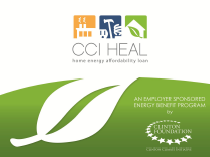Home Energy Affordability Loan Program
Learn about other climate showcase communities.
Little Rock, Arkansas
Federal Funding: $500,000
Project Timeline: February 2011 – December 2012
Latest Update
Through its pilot program work, the Clinton Climate Initiative of Arkansas' (CCI-AR) Home Energy Affordability Loan Program (HEAL) continues to transform the residential retrofit market by using employers to generate demand and engage employees in the residential energy audit and retrofit process. As of September 2012, CCI-AR has completed 131 residential retrofits and 141 energy upgrades. CCI-AR has also identified barrier-free, low-interest financing opportunities for the HEAL program and has established a Rebate Bridge Loan for participants that do not meet Credit Union loan eligibility.
The CCI HEAL program is currently working with two employers: a municipality, the City of Little Rock, and a university hospital, the University of Arkansas Medical Science. Going forward, the HEAL pilot will focus on adding a third party financing model (plus an optional Loan Loss Reserve component). The national HEAL Replication program focused on making current program models available to potential national partners: this has led to seven replication agreements.
Project Summary
Facilitating and Financing the Residential Retrofit Process
The City of Little Rock has partnered with the William J. Clinton Foundation's Climate Initiative - Arkansas (CCI-AR) to continue development of the Home Energy Affordability Loan (HEAL) program. Through the HEAL program, the City of Little Rock is reducing greenhouse gas emissions by improving energy performance in residential buildings and creating a template for the program to be replicated in other communities.
The HEAL program enlists employers to facilitate and administer the program to qualifying employees and community members. This allows the program to overcome a key outreach barrier and engage people at their place of work. Moreover, CCI-AR facilitates financing of energy efficient retrofits for employees' homes, as well as loan repayments through payroll deductions.
Through the HEAL program, Little Rock is offering 375 free energy audits to employees of industry partners and community members, with low-to-moderate income (LMI) employees receiving preference. HEAL also incorporates indoor air quality assessment, implementation, and monitoring protocols to address the high incidence of respiratory ailments and asthma often found in low-income homes. HEAL auditors produce detailed Personal Energy Plans, which outline the audit findings in an easy to understand way and make recommendations for cost effective home energy retrofits.
Little Rock is implementing home energy retrofits for at least 30 LMI program participants with AmeriCorps labor assistance. If an LMI participant decides to move forward with the recommended retrofit measures, HEAL creates a Scope of Work detailing the exact tasks to be performed and the cost of the work. HEAL works with participants to complete the application and relevant paperwork to access financing for their home retrofit. Little Rock then quantifies the impact and effectiveness of the work performed, and compares the savings to the participant's pre-retrofit energy usage.
Finally, Little Rock is working to share the process and lessons learned from creating the program with other communities interested in replicating it. The Clinton Climate Initiative is creating a HEAL program template that includes sample forms and documents, sample marketing materials, before and after energy ratings for each home, frequency and cost benefit analysis of expected retrofits, training protocols, and performance and productivity standards. HEAL will monetize and evaluate HEAL as part of an employer-assisted energy benefit program. Finally, HEAL will incorporate Community Based Social Marketing tools to further engage employees and community residents.
The program will provide many co-benefits, including:
- Reducing energy and utility costs
- Increasing the disposable income of homeowners
- Stimulating the local economy through increased investment by homeowners
- Helping to meet community affordable housing needs
- Improving indoor air quality and public health
Community Characteristics
Population 189,000
Area 116 square miles
Government Type City
Community Type Urban
Median Household Income $43,160
Program Results
|
Reported Results (as of September 2012) |
Projected Cumulative Results |
|
|---|---|---|
|
Annual GHG Reductions |
353 mt CO2e |
985 mt CO2e |
|
Homes Audited |
338 |
375 |
|
Homes Retrofitted |
131 |
75 |

